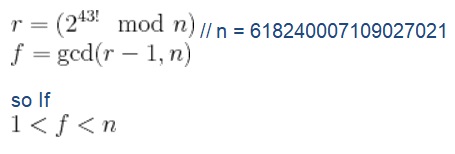Factoring 618240007109027021 using the p-1 method
The p-1 method is used to factor primes for instance p & q such that n = p*q and avoid weaknesses in the implementation of the algorithm.
The method works well when q-1 or p-1 can be factored as a product of given small primes.
Therefore to factor 618240007109027021, we first compute;
2^(100!) mod n using Power (2,100!) mod n
In our case;
n := 618240007109027021
a1: = 100!;
t1 : = Power (2,a1) mod n
a1 = 9.3326215443944152681699238856267e+157
t1 = 78737314835659020
Then we find a factor of n, test if it’s prime, and evaluate how p-1 factors;
factor1:= igcd (t1 – 1, n); // use gcd to find the factor
isprime(factor1) //test if factor is prime
ifactor(factor1-1) //if the factor is prime, test how p-1 factors
so factor1 = 250387201
And it’s true (2)8 (3)5 (5)2 (23) (7)
To find the second factor q, we simply divide n by p and also evaluate how q-1 factors;
Factor2:= n/factor1; // divide n by factor1 to obtain q (factor2)
isprime(factor2) //test if q is prime
ifactor(factor2-1) //if the factor is prime, test how q-1 factors
factor2 = 2469135821
And it’s true, (2)2 (5) (123456791)
Thus the factors of; 618240007109027021 = (250387201) (2469135821);
Let n be the integer in the computer problem 6.9.4 (page 198)
In this case n = 618240007109027021
Therefore from the above calculations, we obtain the following;
p = 250387201
Therefore the small prime factors of p-1 are
(2)8 (3)5 (5)2 (23) (7)
2) We first select a bound for the factorial.
b = ln (n)
is the acceptable limit.
in this case 43.
Exponent is 43! = 6.0415263063373835637355132068514e+52 (factorial of 43)
then we choose some number to raise to that exponential value.
A number ‘a’ from 2 to n-1 can be used.
In this case, I chose 2

Then that’s a factor of n
If not, raise the bound limit.
P = 250387201
//The function to find the prime factors of n is;
public static BigInteger primefactor(BigInteger n) // n is the integer to factorize
public static BigInteger primefactor(BigInteger n) // n is the integer to factorize
return y.subtract(BigInteger.ONE).gcd(n);}
static void execA()
static void factor(BigInteger n)
public static void main(String[] args) //Main method
}
To factor in a larger value of n, you insert the following method in the code;
static void execB()
execB(); // then call execB() function in main
Factoring n = 642401 using the information;
5161072 ≡ 7 (mod n)
And that
1877222 ≡ 22 ∙ 7 (mod n)
n = 642401
Therefore factor1 := igcd (516107*187722-2*7, n); // n = 642401
factor1 := 1129
and we obtain factor2 by dividing n by factor1
factor2 := n/factor1;
factor2 := 569
Thus 642401= 1129 * 569 which are indeed primes
given that 2(n−1)≡ k2_≡ 1 (mod n)
Then we can deduce from “Fermat’s Little theorem” that n is not indeed a prime
number.
Because 2(n−1)/2_≡ ±1 (mod n) and 2(n−1)≡ 1 (mod n)
then From the “basic factoring principle”; k2≡ 12 (mod n)
and k _≡ ±1 (mod n)
Therefore we can find a nontrivial factor of n using the formula gcd(k-1, n) or gcd(k+1, n)